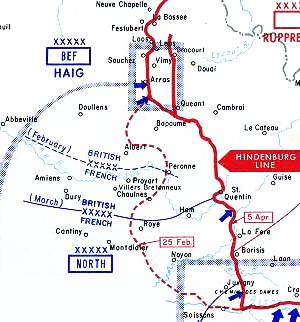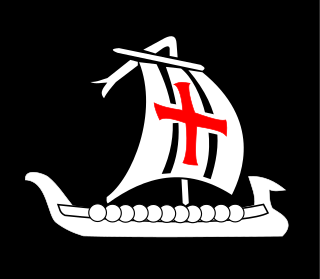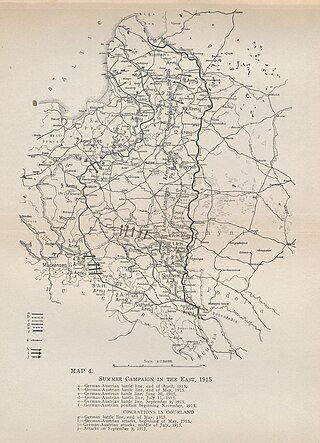
The Battle of Cambrai was a British attack in the First World War, followed by the biggest German counter-attack against the British Expeditionary Force (BEF) since 1914. The town of Cambrai, in the département of Nord, in France, was an important supply centre for the German Siegfriedstellung and capture of the town and the nearby Bourlon Ridge would threaten the rear of the German line to the north. Major General Henry Tudor, Commander, Royal Artillery (CRA), of the 9th (Scottish) Division, advocated the use of new artillery-infantry tactics on his sector of the front. During preparations, J. F. C. Fuller, a staff officer with the Tank Corps, looked for places to use tanks for raids. General Julian Byng, commander of the Third Army, decided to combine both plans. The French and British armies had used tanks en masse earlier in 1917, although to considerably less effect.

The Meuse–Argonne offensive was a major part of the final Allied offensive of World War I that stretched along the entire Western Front. It was fought from September 26, 1918, until the Armistice of November 11, 1918, a total of 47 days. The Meuse–Argonne offensive was the largest in United States military history, involving 1.2 million French, Siamese, and American soldiers, sailors and marines. It is also the deadliest campaign in the history of the United States Army, resulting in over 350,000 casualties, including 28,000 German lives, 26,277 American lives and an unknown number of French lives. American losses were worsened by the inexperience of many of the troops, the tactics used during the early phases of the operation, and the widespread onset of the global influenza outbreak called the "Spanish flu."

The Battle of Łódź or Lodz operation, took place from 11 November to 6 December 1914, near the city of Łódź in Poland. Battles were fought between German units of the Eighth army, Ninth Army, Austrian First Army, and the Russian First, Second, and Fifth Armies, in harsh winter conditions. The Germans redeployed their Ninth Army around Thorn, so as to threaten the Russian northern flank, following German reversals after the Battle of the Vistula River. The German objective was to prevent an invasion of Germany, by encircling and destroying the Russians, as a result, Germans themselves were surrounded and actually lost 2 corps, although the invasion of Germany was prevented Battle had a strong impact on both the Western and Eastern fronts. It ended with the victory of the Russian troops, although the planned invasion of Germany was canceled.

The 42nd Infantry Division was an infantry division of the British Army. The division was raised in 1908 as part of the Territorial Force (TF), originally as the East Lancashire Division, and was redesignated as the 42nd Division on 25 May 1915. It was the first TF division to be sent overseas during the First World War. The division fought at Gallipoli, in the Sinai desert and on the Western Front in France and Belgium. Disbanded after the war, it was reformed in the Territorial Army (TA), in the Second World War it served as the 42nd Infantry Division with the British Expeditionary Force (BEF) and fought in Belgium and France before being evacuated at Dunkirk. The division was later reformed in the United Kingdom and, in November 1941, was converted into the 42nd Armoured Division, which was disbanded in October 1943 without serving overseas. A 2nd Line duplicate formation, the 66th Infantry Division, was created when the Territorials were doubled in both world wars.

The Hindenburg Line was a German defensive position built during the winter of 1916–1917 on the Western Front in France during the First World War. The line ran from Arras to Laffaux, near Soissons on the Aisne. In 1916, the Battle of Verdun and the Battle of the Somme left the German western armies exhausted and on the Eastern Front, the Brusilov Offensive had inflicted huge losses on the Austro-Hungarian armies and forced the Germans to take over more of the front. Romania’s entrance into the war on the side of the Entente in August 1916 had also placed additional strain on the German army and war economy.

The Third Army was a field army of the British Army during World War I that saw active service on the Western Front throughout the war.

The Hundred Days Offensive was a series of massive Allied offensives that ended the First World War. Beginning with the Battle of Amiens on the Western Front, the Allies pushed the Imperial German Army back, undoing its gains from the German spring offensive.

The Battle of Épehy was fought during the First World War on 18 September 1918, involving the British Fourth Army under the command of General Henry Rawlinson against German outpost positions in front of the Hindenburg Line. The village of Épehy was captured on 18 September by the 12th (Eastern) Division.

The Battle of St Quentin Canal was a pivotal battle of World War I that began on 29 September 1918 and involved British, Australian and American forces operating as part of the British Fourth Army under the overall command of General Sir Henry Rawlinson. Further north, part of the British Third Army also supported the attack. South of the Fourth Army's 19 km (12 mi) front, the French First Army launched a coordinated attack on a 9.5 km (6 mi) front. The objective was to break through one of the most heavily defended stretches of the German Siegfriedstellung, which in this sector used the St Quentin Canal as part of its defences. The assault achieved its objectives, resulting in the first full breach of the Hindenburg Line, in the face of heavy German resistance. In concert with other attacks of the Grand Offensive along the length of the line, Allied success convinced the German high command that there was little hope of an ultimate German victory.

The Battle of Canal du Nord was part of the Hundred Days Offensive of the First World War by the Allies against German positions on the Western Front. The battle took place in the Nord-Pas-de-Calais region of France, along an incomplete portion of the Canal du Nord and on the outskirts of Cambrai between 27 September and 1 October 1918. To prevent the Germans from sending reinforcements against one attack, the assault along the Canal du Nord was part of a sequence of Allied attacks at along the Western Front. The attack began the day after the Meuse-Argonne Offensive commenced, a day before an offensive in Belgian Flanders and two days before the Battle of St. Quentin Canal.

V Corps was an army corps of the British Army that saw service in both the First and the Second World Wars. It was first organised in February 1915 and fought through the First World War on the Western front. It was recreated in June 1940, during the Second World War and was substantially reorganised in 1942 for participation in Operation Torch. It fought through the Tunisia Campaign and later the Italian Campaign.

The Second Battle of Bapaume was a battle of the First World War that took place at Bapaume in France, from 21 August 1918 to 3 September 1918. It was a continuation of the Battle of Albert and is also referred to as the second phase of that battle. The British and Dominion attack was part of what was later known as the Allies' Hundred Days Offensive.

VI Corps was an army corps of the British Army in the First World War. It was first organised in June 1915 and fought throughout on the Western Front. It was briefly reformed during the Second World War to command forces based in Northern Ireland, but was reorganized as British Forces in Ireland one month later.
The Leeds Rifles was a unit of the 19th century Volunteer Force of the British Army that went on to serve under several different guises in the World Wars of the 20th century. In the First World War, both battalions served as infantry on the Western Front. They were later converted into an anti-aircraft and tank units, and fought in North Africa, Italy, and Burma during the Second World War.
The Bradford Rifles was a Volunteer unit of the British Army formed in 1859. It went on to become a battalion of the West Yorkshire Regiment in the Territorial Force and saw action on the Western Front during World War I. Between the wars it converted into an air defence unit, serving during World War II first as a searchlight regiment defending West Yorkshire and later as a garrison battalion in North West Europe. Postwar it continued in the Territorial Army in the air defence role until 1955.

The 5th Battalion, King's Own Yorkshire Light Infantry, was a unit of Britain's Territorial Force formed in 1908 from Volunteer units originally raised in the West Riding of Yorkshire in 1860. It served in some of the bitterest fighting on the Western Front during World War I, leading the attack at the tank battle of Cambrai and defending Bucquoy in March 1918. In the late 1930s, the battalion was converted to air defence in which role it served during World War II in the Battle of France and the Dunkirk evacuation, in North Africa including the Second Battle of El Alamein, and in the Allied invasions of Sicily and Italy, including service in the rebellion in Greece. Postwar, its successor units served in Anti-Aircraft Command until 1955.

67th Siege Battery was a heavy artillery unit of the Royal Garrison Artillery (RGA) formed in Scotland during World War I. It saw active service on the Western Front at the Somme, Arras, Ypres, and in the final Hundred Days Offensive.

The First attack on Bullecourt was a military operation on the Western Front during the First World War. The 1st Anzac Corps of the British Fifth Army attacked in support of the Third Army, engaged in the Battle of Arras further north. The Report of the Battles Nomenclature Committee (1921) called operations subsidiary to the main Battle of Arras the Flanking Operation to the Arras Offensive.
The 62nd Guards Rifle Division was formed as an elite infantry division of the Red Army in January, 1943, based on the 2nd formation of the 127th Rifle Division, and served in that role until after the end of the Great Patriotic War.

The Riga–Schaulen offensive was a major Imperial German Army's offensive, launched by the Army of the Niemen of Paul von Hindenburg's group of armies to divert Russian forces from the direction of the main German blow of the summer offensive on Narew. However, it gradually changed into an offensive of two German armies to capture the Kovno fortress and reach the Western Dvina. In the course of a successful offensive, the German army defeated the superior forces of the Russian army and reached the approaches to the important city of Riga.
















